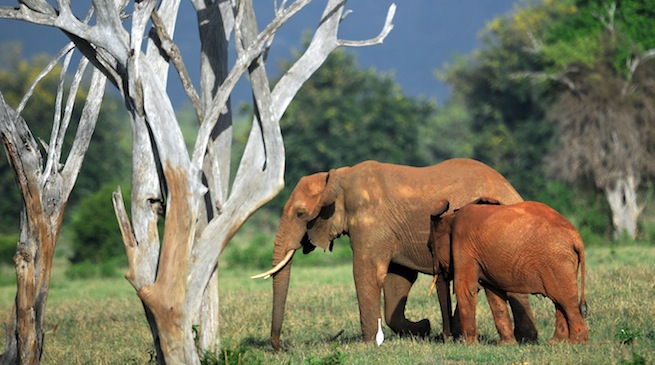
Elephants forage on March 20, 2012 in the Tsavo-east National park during the second phase of a collaring excercise funded by International Fund for Animal Welfare (IFAW) and the Kenya Wildlife Services (KWS) in the wake of a dramatic increase in elephant killings for their prized tusks. Kenya's estimated 30,000 elephant population has come under growing risk as reported incidences of poaching from all over the country continue to mount despite efforts by the government and international wildlife agencies. While speculation points to the influx of Asian nationals into Africa in the last decade as having driven up the demand and with it the price of ivory, IFAW Eastern Africa Regional Director James Isiche said during the excercise that the collared elephants in Tsavo East and West National Parks, will assist in mapping out the migratory corridors in the parks and the buffer zones within the 43,000 square km ecosystem, adding that the need for Kenya to embrace cutting-edge technology in the management of its elephant population is now critical. AFP PHOTO / TONY KARUMBA (Photo credit should read TONY KARUMBA/AFP/Getty Images)
[blogo-video id=”164400″ title=”La carica degli elefanti contro gli ambientalisti in Kenya” content=”” provider=”askanews” image_url=”http://engine.mperience.net/cdn/static/img/tmnews/20160628_video_19424038.jpg” thumb_maxres=”0″ url=”20160628_video_19424038″ embed=”PGRpdiBpZD0nbXAtdmlkZW9fY29udGVudF9fMTY0NDAwJyBjbGFzcz0nbXAtdmlkZW9fY29udGVudCc+PHNjcmlwdCB0eXBlPSJ0ZXh0L2phdmFzY3JpcHQiIHNyYz0iaHR0cDovL2VuZ2luZS5tcGVyaWVuY2UubmV0L0VuZ2luZVdpZGdldC9zY3JpcHRzL3dpZGdldF8xIj48L3NjcmlwdD48ZGl2IGNsYXNzPSJtcGVfd2lkZ2V0IiBkYXRhLW1wZT0ndHlwZT1wbGF5ZXJ8YXBwSWQ9MTl8dGFyZ2V0SWQ9MjAxNjA2MjhfdmlkZW9fMTk0MjQwMzh8cGxheWVyT3B0aW9ucz17ImF1dG9wbGF5Ijoibm9uZSIsImFkdlVSTCI6Imh0dHA6Ly9pYi5hZG54cy5jb20vcHR2P21lbWJlcj0zNzA3JTI2JWludl9jb2RlPXByZXJvbGwtYXNrYW5ld3MteDUwLWRlc2t0b3AiLCJ1c2VJbWFTREsiOnRydWV9Jz48L2Rpdj48c3R5bGU+I21wLXZpZGVvX2NvbnRlbnRfXzE2NDQwMHtwb3NpdGlvbjogcmVsYXRpdmU7cGFkZGluZy1ib3R0b206IDU2LjI1JTtoZWlnaHQ6IDAgIWltcG9ydGFudDtvdmVyZmxvdzogaGlkZGVuO3dpZHRoOiAxMDAlICFpbXBvcnRhbnQ7fSAjbXAtdmlkZW9fY29udGVudF9fMTY0NDAwIC5icmlkLCAjbXAtdmlkZW9fY29udGVudF9fMTY0NDAwIGlmcmFtZSB7cG9zaXRpb246IGFic29sdXRlICFpbXBvcnRhbnQ7dG9wOiAwICFpbXBvcnRhbnQ7IGxlZnQ6IDAgIWltcG9ydGFudDt3aWR0aDogMTAwJSAhaW1wb3J0YW50O2hlaWdodDogMTAwJSAhaW1wb3J0YW50O308L3N0eWxlPjwvZGl2Pg==”]
Nel parco di Mount Elgon in Kenya l’ambientalista anglo-malese Ian Redmond, noto biologo tropicale di fama internazionale, stava fotografando alcuni elefanti in compagnia di un team del Mount Elgon elephant monitoring (Meem), sponsorizzato dalla Born free foundation, di cui il naturalista è membro, quando a un tratto il gruppo è stato attaccato dai pachidermi.
Redmond stava osservando un branco a circa 150 metri di distanza quando un grosso esemplare maschio si è voltato e ha caricato la squadra, le cui telecamere hanno catturato alcuni fotogrammi dell’aggressione (potete vederle nel video in testa a questo post).
Redmond se l’è cavata solo con una spalla lussata e qualche escoriazione a collo e torace e certamente ci penserà due volte prima di avvicinare nuovamente così tanto, e per così tanto tempo, un gruppo di elefanti. Redmond ha affermato al Daily Mirror di ricordare perfettamente l’accaduto, comprese le sensazioni di spinta e di contatto con l’elefante: si è salvato solo grazie all’intervento dei ranger, che sparando colpi in aria hanno spaventato gli animali che se ne sono andati: ha monitorato ed osservato quelle bestie per 36 anni e afferma che non si erano mai comportati in quel modo.
Secondo una plausibile ricostruzione il branco era molto stressato sia per le attività di bracconaggio che per quelle carbonaie, che mettono a rischio l’incolumità degli elefanti.



